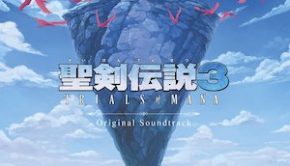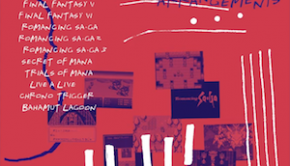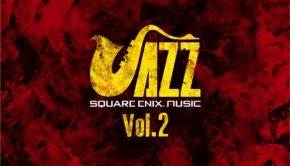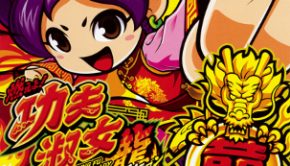Atelier Escha & Logy -Alchemists of Dusk Sky- Original Soundtrack
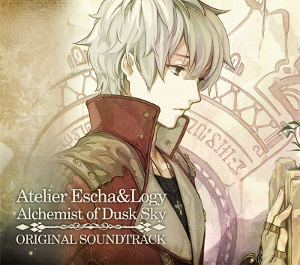 |
Album Title: Atelier Escha & Logy -Alchemists of Dusk Sky- Original Soundtrack |
| Record Label: Gust |
|
| Catalog No.: GUSTCD-10011/3 |
|
| Release Date: Jun 26, 2013 |
|
| Purchase: Buy at CDJapan |
Overview
Concurrent with the release of Atelier Escha & Logy: Alchemists of the Dusk Sky, Gust Inc. published two albums containing the instrumental and vocal music of the game. This review focuses on the instrumental songs included in its original soundtrack. Given that this game is the 15th installment in the Atelier series, the company decided to go all-out with the music team for this time; aside from the return of the team that scored its predecessor Atelier Ayesha: Alchemist of the Dusk Ground, several guest composers like Mana composer Hiroki Kikuta, doujin favourite Hideyuki Kinoshita, and AliceSoft’s Shade lent a hand in making the music for it. Does it maintain enough of the identity from its predecessor and also move in new areas with the introduction of the other composers? Or does the album fail to continue the established sound from Ayesha in a satisfactory manner?
Body
The soundtrack for Atelier Escha & Logy does maintain the sound that was so prevalent in Atelier Ayesha: it has somewhat of a relaxed sound for environment and scene setting pieces, as well as some emotional event ones, but has a much more intense and exciting feeling to it for when it comes to the battle themes. What’s more, it’s also every bit as extensive as Atelier Ayesha was: it spans three CDs full of music, which we could say is the new standard set for Gust’s albums ever since Atelier Meruru: The Apprentice of Arland was released.
First, I have to say that a few songs returned from Atelier Ayesha, mostly due to the returning characters. The new version of Nio’s theme, “A Flower Blooming Nearby part 2” is relatively similar to the original, but with more percussions and replacing the main piano line with oboes and flutes, which makes it feel bouncier though I personally prefer the orgel version from Ayesha. The same could be said for the redux of Willbell’s theme, “A Baby Bird part 2”, which has a sillier feeling than its original due to the changes in instrumentation. It could be said that Kazuki Yanagawa decided to give them a quirkier atmosphere in comparison to their versions from Ayesha.
Daisuke Achiwa’s Ayesha theme, “The Pen and the Sword.” also receives three rearrangements. While this one was a given due to Linca and Marion’s reappearance, I have to say that it’s a bit astonishing to have so many rearranged versions of the same song. The first one, “The Pen and the Sword part 2” has a jazzy sound that wouldn’t be out of place on a bar, while “The Pen and the Sword part 3” is more similar to the original version but more rock-styled. And comically enough, the third rearrangement, “FJ:The Pen and the Sword part 3” is actually a shortened edit of the normal part 3 with a more abrupt ending, which is used for Linca’s special when used to finish off a battle. As for “Close to the Edge part 2”, I have to say that Yu Shimoda deviated a bit from his original work due not only to the song being shorter, but also due to giving more emphasis to the synth than to the electric guitar riffs, not to mention the addition of the synth noises.
Now going to the tracks that are original to the game itself, Daisuke Achiwa unfortunately only got to work in two of the battle themes on this game, but fortunately the ones he made don’t disappoint when it comes to their quality. A good example of this is the basic battle theme “Fulcrum”, with its intense percussions, the guitar riffs on the background, which take the center of the stage midway through it, and the sound effects that can be heard occasionally through it. “Roar”, on the other hand, starts off much softer with a bouzouki, guitar and accordion based melody, which then give way to a pan flute and introduces an electric guitar later on. The song itself remains at a relatively calm pace during its entire length, but it feels somewhat enthralling for a battle theme despite that.
Achiwa also worked on several of the silly songs for the soundtrack: “Rice and Meat Anthem” is an over-the-top orchestral piece that features prominently the tuba and a male chorus in the background. “What I Should Do?” is a bit more low key due to lacking the chorus and orchestra and instead opting for a more jazzy tone, but it still gives that same sensation of bearing witness to a nonsensical situation. And the same could be said of “Too Late”, though it plays at a much slower tempo and with a lack of enthusiasm. As for “Big-Breasted, Melancholic Woman”(!), it also keeps the same trappings of the previous songs, but with more of a polka sound due to the use of the accordion.
However, not all is silliness. Achiwa also contributed some of the event and location themes, such as “To the Land Without a Name” with its accordion, woodwind and guitar melodies; “Looking up at the Sky” with its pizzicato and flute that are joined later on by bells; or “Apple Tree” with its warm and soft woodwind and guitar-based sounds. There is also the sadder piano and strings ballad “Rut of Time”, the sentimental woodwind, harp and flute ensemble “Alone in a Room”, or the depressing guitar and piano duet of “Remorse”. However, I can’t deny that I felt that all these pieces were reusing elements from the soundtracks for Atelier Iris 2, Mana Khemia, and Atelier Lina. However, there are also some new elements to find in some of his other contributions: “The Glasses are Boiling” is an interesting mix between Celtic and electronica; “Hummingbird” sound like a jazzy reprise of some of the melodies and rhythm patterns he has employed through the years; and “Belly’s Bullet” has a sound that wouldn’t be out of place in a western.
Moving on, we have Kazuki Yanagawa. While I originally wasn’t very impressed with his compositions in Ar tonelico Qoga: Knell of Ar Ciel, I have to say he has greatly improved with every game he has taken part in. While he also indulges on a folksy sound similarly to the one Ken Nakagawa used to have, he also produces strong orchestral pieces like “Both Wings”, which can be heard on the world map screen and was also used in the PV announcing the anime adaptation of Atelier Escha & Logy. Another interesting piece would be “In the Nest That Has no Worker Bees”, which aside of the orchestral base also makes use of bagpipes and is quite the intense piece. There’s also the baroque-inspired “Stretch” with its harpsichord, oboe and elegant orchestral sections, which I think wouldn’t be out of place in a palace or something similar. “Spicy Sugar” also has something of a royal theme to it, and though it lacks the baroque feeling, it does feel like being in presence of something majestic despite the somewhat silly name.
On more tranquil terms, he also contributed the serene “Cloud Harbor”, which really feels calming with its strings and harmonica, and personally I feel it wouldn’t have felt out of place in a game like Final Fantasy: Crystal Chronicles. And on the funny side, we also have the Italian-inspired “Kitchen Dance” made up from accordion, guitar, bells and orchestra; though I have to say that it can defined as overdone (if I might be excused for the kitchen puns) due to the excessive force used in the percussions on some of the sections, though it also has a nice guitar solo near the end. Yanagawa also made the exciting “Updraft”, which really gets the player pumped with its violin, flute and piano, and is pretty fun to listen, though I have to admit it fooled me at the start, since at points it sounded more like something Achiwa would have made.
Next we come across Yu Shimoda’s work. I’m not still very familiar with his work, but I have to say it’s somewhat out of tune with the rest of the music the Gust Sound Team members have made throughout the years: one example of this is “Magnum Opus” with its piano lines that seem like something out from a noir film. The same thing could be said about “Alchemist Escha’s Case File”, which has a quiet and creeping tone that sounds perfect for a mystery story. There’s also the tense “Again, the Red Nightmare”, which is made up by piano, drums and noises, which coupled with the preceding ambient noise track “And then, In a Place Where People Once Were”, is quite chilling. He also demonstrates a more emotional side with the sister pieces “Promise (Piano Version)” and “Promise (Dusk Hill)”: while both pieces are very similar, the former starts slower and with a simpler arrangement; while the latter already begins on the faster part and gets a slightly more complex arrangement on its second half, as well as a more developed melody.
However, he’s not all mystery: “Germination” has a classic rock ’n’ roll sound to it that reminds me a lot of the songs of The Beatles, “Formation” is an interesting demonstration of synth mixes that gives the sensation of seeing liquids mix together in testing tubes, while “Fly in the Blue Sky” has an emotional sound that then develops into an exciting one. Finally, similarly to what he did in “Close to the Edge”, he also made the hard-rock battle theme. “Don’t Panic”. It has a rather strong beginning that really makes one feel some panic, but while it softens up a bit around a minute in, this synth-based rock piece regains its energy rather quickly, and it doesn’t let up until the end after that. There is also the song “Love the Dragon -Don’t Kill the Dragon-”, which is more of an orchestral piece with some guitar riffs, though I feel it’s somewhat slow and lacking in variety for an epic battle, since this song is heard during battles with some relatively hard to defeat dragons. I’d also like to point out how contradictory the title is for the situations where it is used.
Next, we come to the contributors of the guest composers, beginning with the famous Hiroki Kikuta. First we would have the harp-based “Pavane”, which is a slow and beautiful piece that seems to be reserved for sad situations. Next we would have “Simulacra”, which is quite a happy sounding piece formed by pizzicato and bells initially, but then drums and a keyboard about half a minute in, and it’s really uplifting for the mood. I have to say these two pieces brought me a lot of memories back from “Spirit of the Night” in the case of the former, and a sort of mix of “The Color of the Summer Sky” and “What the Forest Taught Me” from Secret of Mana, but both are really beautiful pieces that can stand very well on their own. Kikuta also contributed a bit with the action, as he was also in charge of the basic battle theme “My Name is Legion”, which is a drum and keyboard piece that evokes a lot of energy. Similarly is the piece “Dorothy’s Tiger”, which has a more intense rhythm but a more enthralling melody, though it also includes some nice guitar solos and finishes in a nice combination between both instruments before looping.
Then we come to Hideyuki Kinoshita’s compositions. I have to say that Kinoshita is a complete mystery to me because I haven’t listened to his music before, despite his prolific involvement in doujin albums, but I did gain a liking for his style after listening to him here. “consolation” is a sorrowful piano solo that really tugs at the heartstrings. The following “Evening Melody” is also a piano solo, but it has a more hopeful sound to it that really feels nice after the sadness from the previous song. Kinoshita’s last addition to the soundtrack is the fun “Working People Ragtime”, which is just what it says: an entertaining ragtime made of piano and drums which feels like something that would propel someone to dance. AliceSoft veteran also contributes an extended instrumental version of “Sky of Twilight”, also featured in a vocal rendition on the game’s vocal album.
Moving to the vocal tracks featured on the soundtrack, the release opens with the game version of “Milk-Colored Ridge”, sung by vocalist Yumi Nakashima under the pseudonym Yuu. I can only describe it as a slow rock song, though I feel it’s somewhat out of tune not only with Ayesha’s opening (“Flower Marks”) but also with those of the previous Atelier games due to its musical style. However, Yuu still does a nice work with the singing, as also do the rest of the Chirinuruwowaka members to which she belongs. Next, we come to the ending song “Sweet Reward”, also interpreted by Yuu and the rest of Chirinuruwowaka. While it’s a nice song, I somehow feel it doesn’t fit with the ending either, as it’s somewhat heavy and dark in tone for the name it has and the kind of endings the Atelier games tend to have, despite fitting well with the way the credits roll is presented. Though I have to point out it’s interesting how they fake out the listener by making it seem like it ends near the halfway point to then continue it.
And finally, we have Yu Shimoda also in charge of the instrumental medley that closes off the album and serves as the BGM for the second part of the credits roll, which is titled “Burning Sunset -Goodbye Dusk Sky-”. After beginning with a soft piano part, it leads in the listener with a beautiful choral performance. It then passes to a rearranged version of Yanagawa’s “Both Wings”, replacing the orchestra with synth, and making several beautiful alterations to the original piece. Finally, it ends with a beautiful synth-orchestra melody, which serves as the perfect way to close off the album.
Summary
While in the end the Atelier Escha & Logy original soundtrack is another solid album and a good addition to the series’ overall repertoire, I have to note it feels less consistent than the Atelier Ayesha soundtrack. Maybe it is due to the different styles and samples used by the many composers involved, but it feels like there isn’t a unified theme or style running throughout it. I also have to say that there are some pieces that feel somewhat underdeveloped due to not having enough variation or changes in their overall structure. However, this doesn’t offset the things the album does well, and I can only hope the soundtrack for Atelier Shallie: Alchemists of the Dusk Sea is of the same level or even better.
Do you agree with the review and score? Let us know in the comments below!
4.0
Posted on August 16, 2014 by Gerardo Iuliani. Last modified on January 22, 2016.

